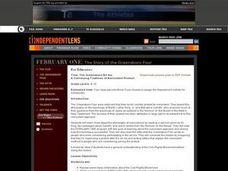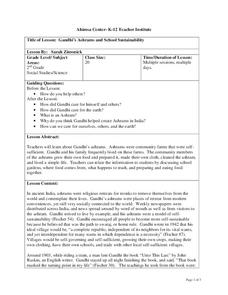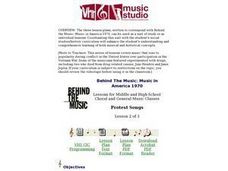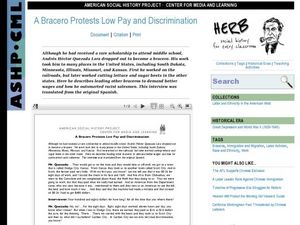Curated OER
Introduction to the Reformation
Ninth graders investigate the Protestant Reformation. In this global history instructional activity, 9th graders examine the provided primary sources that enable students to create posters and presentations that reveal how Catholicism,...
Curated OER
Reasons to Settle in America
Students complete a research project. In this American History instructional activity, students work in groups to research reasons that people wanted to settle in America. Students record the information, share what they found and...
Curated OER
Gandhi’s 12 Vows: Training Warriors of Non-violence
Students examine Gandhi’s ‘Walk n Talk’ strategy. In this lesson on civil disobedience, students evaluate Gandhi’s non-violent method of satyagraha as an effective mode of revolution.
Curated OER
Art for Protest or Persuasion
Students examine Chicana/o and earlier prints made for protest and persuasion. They compare characteristics of different processes and distinguish multiple original prints from mass-produced reproductions of artworks.
Curated OER
Art for Protest or Persuasion (Mural Options)
Young scholars examine various murals made for protest or persuasion purposes. Using the artwork, they identify the different types of techniques and media used to make them. They discuss the other types of jobs that had to be completed...
Curated OER
The Power of Protest
High schoolers explain how Rosa Parks refused to give up her bus seat to a white man. They discuss how her actions were heroic and how they affected the civil rights movement. They reflect on the lesson in journal entries.
Curated OER
The Greensboro Sit-Ins: A Continuing Tradition of Nonviolent Protest
Pupils watch a video about nonviolent protests during the Civil Rights Movement. They discuss and write about the Greensboro sit-ins while deciding the effectiveness of this type of protest.
Curated OER
Nonviolent Protest Around the World
Twelfth graders complete research that exposes them to examples of nonviolent protest throughout the modern world. In this nonviolent protest research lesson, 12th graders discover information about signification nonviolent movements...
Curated OER
Nonviolent Resistance: Gandhi and King
Students use the internet to research the major events and dates of Mohandas Gandhi and Martin Luther King, Jr. In groups, they use this information to create a poster to present to the class. They reflect on how these two men were...
PBS
From Selma to Montgomery: An Introduction to the 1965 Marches
The 1965 Civil Rights marches from Selma to Montgomery and the resulting Voting Rights Act of 1965 are the focus of a social studies lesson. The resource uses film clips to inform viewers not only about the discrimination that gave rise...
Anti-Defamation League
Student Dress Codes: What's Fair?
The controversy over school dress codes continues. The debate involves questions like, why is there a policy? Who sets the policy? Who enforces the policy? What is a fair policy? Tweens and teens have an opportunity to engage in the...
Curated OER
Gandhi's Ashrams and School Sustainability
Explore philosophy and religion by researching Gandhi. Lead your young students to investigate the life and accomplishments of Mahatma Gandhi by reading the assigned text. Your class will define sustainability and create a sustainable...
Curated OER
Clash of Cultures and Marching North
Each of the 23 slides that comprise this presentation are intended to enhance or support lessons on shifts in religion and the colonization of the Americas. Students are guided through the changes in religion that ultimately lead to the...
Curated OER
Protest Songs
Students analyze and perform an American social protest song. They describe its historical setting, consider the effectiveness of the music and recognize that popular music is a reflection of American culture.
Curated OER
A Bracero Protests Low Pay and Discrimination
In this primary source analysis activity, students analyze an interview with a bracero. Students respond to 3 short answer questions based on the interview.
Curated OER
Dealing With The Problem of Poverty: The Elizabethan Poor Law
In this English history worksheet, students read a detailed one page text with information about poverty and the laws regarding deserving and undeserving poor during the 1600s in England. Students answer 10 multiple choice and essay...
Curated OER
Countryside Protest in London
Students, in groups, discuss questions about a protest in London, England. They examine the differences between living in the city and the country.
Curated OER
Songs of Protest/Songs of Unity: 1865 to the Present
Learners study song-poems from 1865 to the present. They explore the works of Woody Guthrie and the Almanac Singers (including Pete Seeger).
Facing History and Ourselves
The 1968 East LA School Walkouts
The East LA School walkouts are the focus of a lesson that looks at the importance of an education that honors the culture of all learners. Class members watch videos and read an article on the LA student demands to gather background...
Curated OER
Iraq anniversary: No celebration
Students read news articles/television reports about the D.C. protests and other similar war protests. They investigate the laws that relate to such protests. Students present their findings to the class.
Curated OER
Speaking Out Against War
High schoolers discuss the affect the Iraq War has had on citizens taking advantage of their right to express themselves through non-violent protests and pledges of resistance. They research and discuss local community and school events...
Curated OER
Making Art That Matters (Printmaking Option)
Young scholars plan and execute a relief print that attempts to protest or persuade. They focus on effective definition of shape, use of symbols, and impact on their intended viewers.
Curated OER
Making Art That Matters
Students plan and execute a mural, in small groups, that attempts to protest or persuade. They focus on effective definition of shape, use of symbols, and impact on their intended viewers.
Curated OER
New Voices for African Americans
Eleventh graders study Malcolm X and black power. In this African American lesson, 11th graders write a journal entry about black power and create a timeline of the events during the civil right movement.

























